CES 2010 TV Trends - 3D, Ridiculously Thin and Connected
by Manveer Wasson on January 9, 2010 5:00 PM EST- Posted in
- Trade Shows
This was the first year that CES wasn't predominantly a display show. Despite the focus on tablets, smartbooks, netbooks, eReaders and other wireless tech, the display guys were all there in full force.
All of the major TV vendors (LG, Panasonic, Samsung, Sony and Toshiba) held press conferences the day before the show officially opened. We spent the past day looking at all of the TVs and tried to get a feel for what improvements you can expect in 2010.
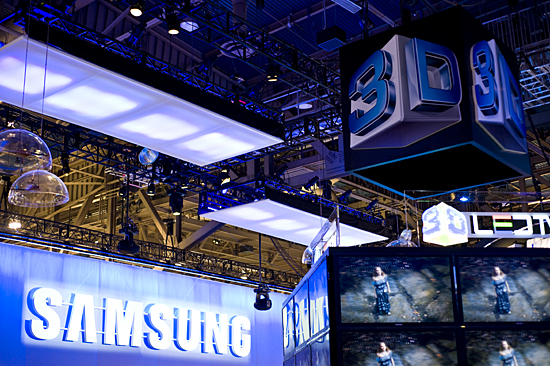
In 2009 we saw the trend moving towards slimmer televisions with the use of LED backlighting. This year however, the hype is all about 3D. Although prototypes of these 3D sets were shown off in previous years, this year we saw a full lineup of 3D home theater solutions from all the major TV manufacturers. In just the past year we saw the release of several blockbuster 3D movies (Avatar, Monsters vs Aliens, Up!) and CE companies are banking on customers wanting the same 3D experience at home. In addition to the the TVs, we'll also see 3D content from providers like DirectTV, ESPN, Fox Sports, and Dreamworks. We'll also see a complimentary lineup of Blu-Ray 3D capable players and HDMI 1.4 to push the content to the screen.
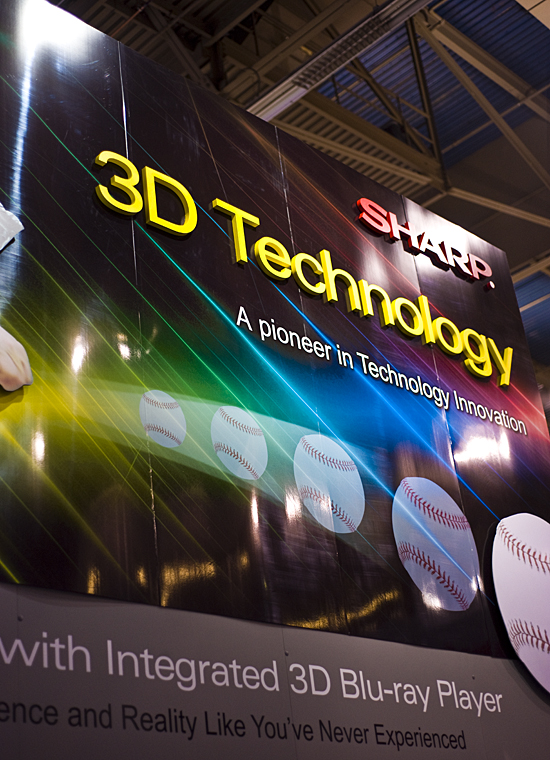
Toshiba, Samsung and Sony are also advertising the ability to convert 2D content into 3D in real time on their respective sets. Each of course claims to have the "best" implementation of this functionality (Toshiba even uses the Cell processor).
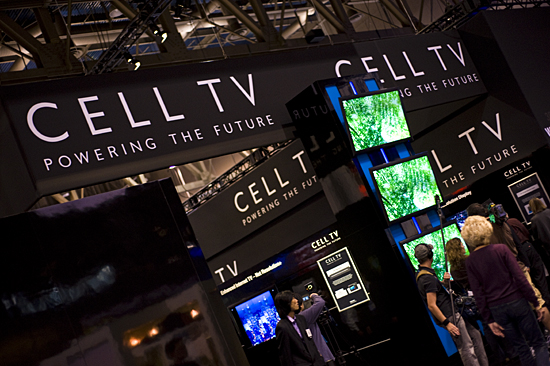
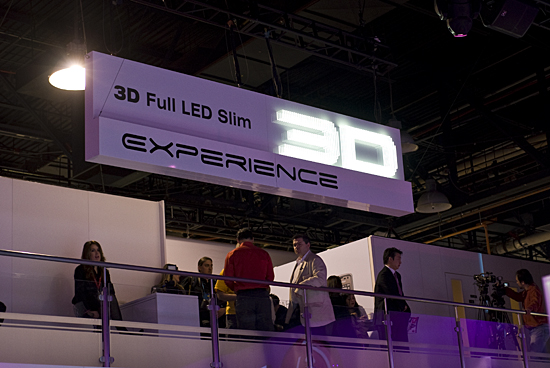
We had a chance to check out some of the 3D offerings on the show floor today to see if these sets lived up to the hype. The implementation of 3D varies slightly between manufacturers however for the most part all the major players are using active-shutter glasses to produce the 3D effect. This is the same technique used by NVIDIA's 3D Vision which we looked at last year . The glasses are required in order to view the 3D material properly, so if you and your friends want to enjoy a 3D movie, they'll need to each have their own pair of glasses.
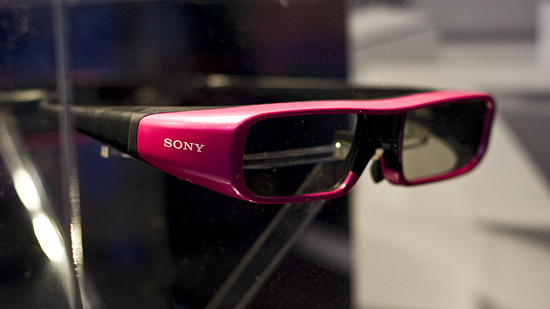
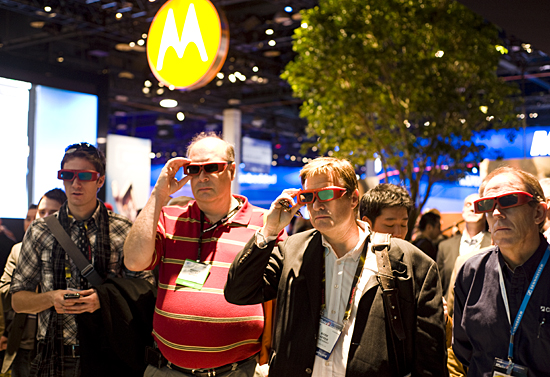
Active-shutter glasses communicate wirelessly to the TV to sync the shutters to the refresh rate of the set. If you have a TV with a 120Hz refresh rate, the TV will display a left or right frame of the stereoscopic image every 1/60th of a second, or at a rate of 60Hz, and your glasses will open the shutter of the corresponding eye. So essentially your 120Hz TV will be able to display 3D content at 60Hz.

A minimum of a 120Hz refresh rate is needed to ensure flicker-free 3D content delivery. Panasonic seems to going with the bare minimum here however Toshiba and LG are boasting refresh rates as high as 480Hz.
Another difference to note with this year's lineup of 3D devices is HDMI 1.4. This latest HDMI standard includes official support for stereoscopic 3D formats, however existing high speed HDMI 1.3 interfaces can also be used for 3D.
In our short time viewing the demonstrations on the show floor, we can say that the experience of 3D in the home is very similar to what you get at your local cinema, albeit on a smaller scale. Right now the price premium for 3D doesn't justify the experience, but perhaps that will change over time. Hopefully we will see more content that will push this technology artistically.
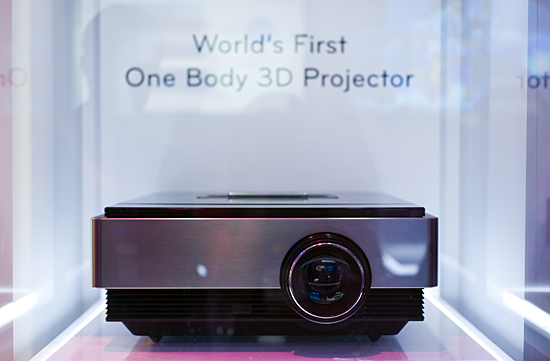
Another common theme for TV's this year was the broadening lineup of LED TVs. Although LED TV's have been selling for a few years now, the choices for these desirable sets have been slim and pricing was set at a premium. Expect the variety of LED based TVs to increase significantly for 2010. Of the 10 new Toshiba TV series' announced at the show, 7 will be LED. The LED sets also continue to get thinner as well with Samsung boasting that their LED9000 series set is 0.3" thick. LG takes the crown in being the "worlds slimmest" LED backlit LCD TV at 6.9mm (0.27") thick. In either case, they both look very slick with the LG set winning our approval for most elegant design. Sony however couldn't keep up in the thin race this year as all their LED backlit sets were noticeably thicker than the competition. Their "monolithic" design branding doesn't help invoke a feeling of thinness either.

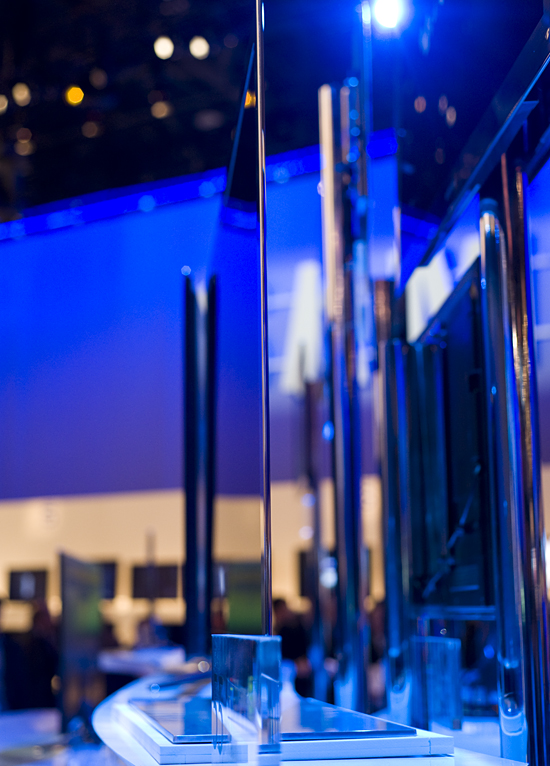
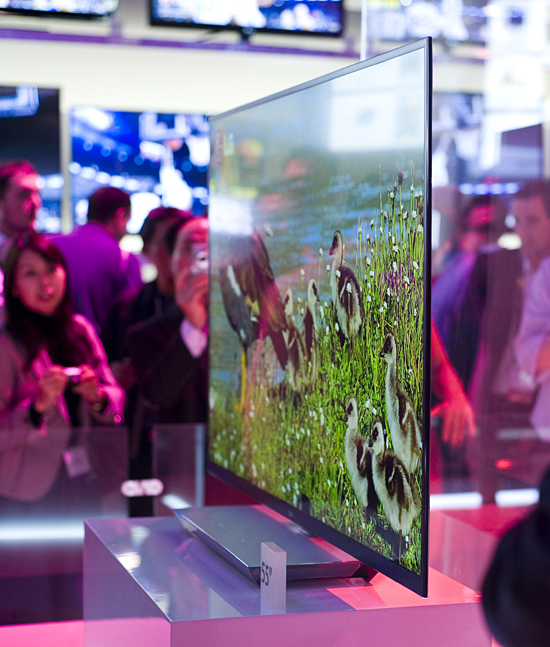
The ultra-thin TVs are arguably more interesting visually than 3D content displayed on them. It won't be too much longer before these things are light enough to hang directly on a wall or with minimal mounting hardware.
Finally this year saw a growing trend in "connected" TVs. These sets will integrate ethernet and wireless network capabilities to stream content from external devices and the internet. All the major brands were touting DLNA certified models that can view movies, music, and pictures stored on a network device directly on the TV. Samsung has upped the ante here by allowing their premium line of LED TVs (6000, 7000, 8000, and 9000 series) to run 3rd party apps. Samsung is calling their foray into an Apple-like app store "Samsung Apps" which expands on their Internet@TV service launched last year.
Companies like Samsung are moving in the right direction in terms of connected home entertainment with DLNA, however it still has a ways to go before it matures. If you already have a nice TV, it's not worth upgrading just for DLNA. Set top devices like the Popbox and the Boxee already provide the ability to stream almost any type of media to your TV in addition to streaming content like Netflix and Hulu.
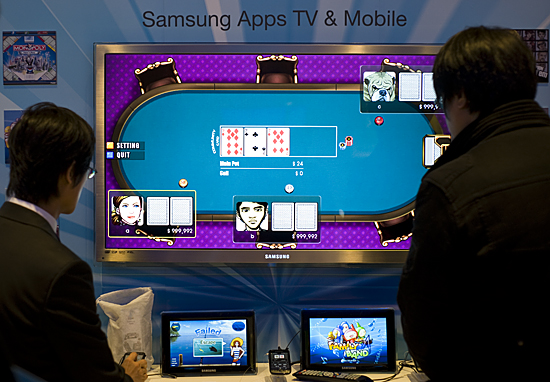










35 Comments
View All Comments
cmdrdredd - Sunday, January 17, 2010 - link
"sorry to say you have NO clue what 3D tech nowadays is about. You cant even compare this what you saw "in the 80s". Do me favor see avatar or a recent 3D movie in Imax.I myself already own a 50" 3d plasma. Real field sequential 3d will be the future, whether you accept it or not."
I did watch Avatar in 3D at the iMAX and honestly wasn't impressed. The color and sharpness of the picture wasn't there. It was 3D sure, but it took the image quality away in the process. I want 1080p clarity and the color clarity of the best Plasma with a 3D image. If they can't do that, they failed.
rbfowler9lfc - Monday, January 11, 2010 - link
That's like saying "I'm not playing DOOM, that's fake 2.5D pictures, this still isn't 3D" in 1993.That's like saying "I'm not taking the Apollo 11, that's a fake spaceship, it would leave the solar system if it were a real spaceship" in 1969.
EVERYTHING has its time. NOW we have shutter glasses, maybe in 2020 we'll have cheap holographic, truly 3D TV sets.
marvdmartian - Monday, January 11, 2010 - link
Definitely not worth upgrading solely for the purpose of getting 3D (or 2.5D).Come see me when you can offer me 3D holographic projection in HD quality, and we'll talk. (think R2D2's projection of Princess Leia in Star Wars, only much larger and much much better quality).
Zero110 - Sunday, January 10, 2010 - link
FlyTexas,Just a counterpoint from someone who is interested in this tech (mostly for more immersive gaming). I don't understand how it would even be possible to display anything but a fixed perspective with live-action footage. The only way I know of to create 3d films is with a two-camera system, so I don't know how something like you describe would work.
With computer graphics, because the images are being generated, you could have something where the display changes based on your perspective. There are HUD systems (like those cheesy VR systems that were all the rage in the mid-90's) that track your head movements and change the perspective based on that information.
Yes, having to wear glasses is not optimal, but short of holodeck technology or possibly some sort of adaptive tracking system that shoots laser beams into each eye, I don't see how you can make a floating 3d display that isn't horribly washed out/not real looking, like those old sega holograph FMV arcade games.
FlyTexas - Monday, January 11, 2010 - link
Ok, ok... so my post came off a bit ranty...I'm just annoyed that they think we'll spend thousands to replace our brand new TVs.
Ok, granted, if you haven't upgraded yet, fine... But even then the price gap will still be there for awhile. You can get a really nice 46" 1080P LCD for under $1K. Some of these sets they are talking about are in the $2K price range.
As for the live action footage, you have a point, using normal motion picture cameras. I'm just making the point that real 3D is a projection into empty air and that the image changes depending on where you stand. (think Avatar, but using sampled information from the real world, rendered in real time by the computer, completly photorealistic in every detail, all it takes is lots of computer power)
What we have here is enhanced 2D, since it is giving you depth information in a 2D image.
Actually, I do see there are effects that can be done well with this, that actually might be harder with true 3D. You can create a depth of field greater than you have in the physcial room, something hard to do with a 3D projection, unless of course you have a back surface to project distances on (think the walls of the holodeck).
But we are a LONG ways off from that, so whatever... :)
Hmm, I got off on a rant again, didn't I? Sigh...
My two points are this...
1. I just purchased 1080P LCDs to replace my tube TVs, I'm not replacing them again for awhile.
2. I am not going to wear glasses in my living room to watch TV.
My 2 cents... :)
flexy - Tuesday, January 12, 2010 - link
>>3D is a projection into empty air and that the image changes depending on where you stand
>>
this will be a FAR, FAR way to go since as of now we still depend on what the camera (or computer) saw - there is not even a hypothetical way thinkable right now to "film" a scene with infinite view-points and then reproduce it in "real" 3d where you can walk around the scene as you like. (Say: holographic movie etc..etc)
That being said, the fact that CURRENT 3D will "only" reproduce what the director (respective the camera) saw is already a HUGE step compared to flat 2D. Dont forget that not many years ago 3d was really bad with red/green glasses...and its already come a long way..see avatar or the latest 3d imax movies.
As for the glasses....its funny how many people complain about the glasses....but then there are people who wear REAL glasses the whole day long <-- doesn't make sense, really. I don't consider the latest clear polarized 3d glasses such a big annoyance anymore, really. Its not that you need to wear a helmet or something.
Go show a little positive support for such exciting tech, instead of bashing it right away. 3D is a very cool thing and its getting better and better and more consumer-friendly.
cmdrdredd - Sunday, January 17, 2010 - link
[Quote}As for the glasses....its funny how many people complain about the glasses....but then there are people who wear REAL glasses the whole day long <-- doesn't make sense, really. I don't consider the latest clear polarized 3d glasses such a big annoyance anymore, really. Its not that you need to wear a helmet or something.[/Quote}If I wear glasses now, I can't wear 2 pairs of glasses comfortably. So your point is ill thought out. The problem is I need 6-8 pairs of these glasses at $50 a pop. That's a LOT of money just to watch TV. No thanks. I don't know about you but I don't always watch TV alone.
rudy - Sunday, January 10, 2010 - link
A computer is a generated scene it is very easy for them to place "cameras" anywhere in the scene they want. This is why you can become spectators in game or view third person or any view you like. The bigger question is will drawing the same scene 3 times and doing some post processing to come up with the final image be able to be completed fast enough to keep FPS gamers happy. On older games I can see it being done easily but people don't pay to see 3D on old bad graphics they want to see it on the latest graphics. My personal belief is that games will be able to do it easier and better then movies can because the whole scene is artificial.bigboxes - Sunday, January 10, 2010 - link
Yup. This 3D is still gimmicky. Those thin sets do look sexy and I'm all for it, but we really need a more thorough review on the picture quality and viewing angles. Plasma still wins hands down and I'm not sold on LCD even with LED backlighting. Was there any new OLED screens on display at CES?cmdrdredd - Sunday, January 17, 2010 - link
The problem with 3D will be market adoption and penetration into homes. Not necessarily the sets themselves, but the content that you can get on them. If there's only 3 channels and it costs you an extra $10 for them on your Cable or SAT provider, that's going to be a hard sell. They need a 3D standard so that NBC, ABC, FOX, CBS and multiple cable networks like USA and TNT etc. jump on and produce shows that take advantage of 3D. Just watching a few nature showys on Discovery and some soccer games on ESPN is a joke.